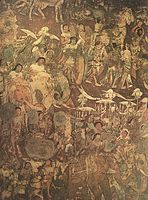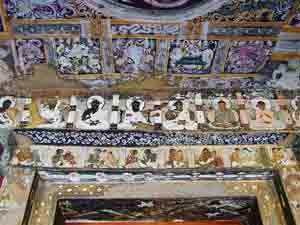The paintings in the Ajanta caves predominantly narrate the Jataka tales. These are Buddhist legends describing the previous births of the Buddha. These fables embed ancient morals and cultural lores that are also found in the fables and legends of Hindu and Jain texts. The Jataka tales are exemplified through the life example and sacrifices that the Buddha made in hundreds of his past incarnations, where he is depicted as having been reborn as an animal or human.

Mural paintings survive from both the earlier and later groups of caves. Several fragments of murals preserved from the earlier caves (Caves 10 and 11) are effectively unique survivals of ancient painting in India from this period, and “show that by Sātavāhana times, if not earlier, the Indian painters had mastered an easy and fluent naturalistic style, dealing with large groups of people in a manner comparable to the reliefs of the Sāñcī toraņa crossbars”. Some connections with the art of Gandhara can also be noted, and there is evidence of a shared artistic idiom.

Four of the later caves have large and relatively well-preserved mural paintings which, states James Harle, “have come to represent Indian mural painting to the non-specialist”, and represent “the great glories not only of Gupta but of all Indian art”. They fall into two stylistic groups, with the most famous in Caves 16 and 17, and apparently later paintings in Caves 1 and 2. The latter group were thought to be a century or later than the others, but the revised chronology proposed by Spink would place them in the 5th century as well, perhaps contemporary with it in a more progressive style, or one reflecting a team from a different region. The Ajanta frescos are classical paintings and the work of confident artists, without cliches, rich and full. They are luxurious, sensuous and celebrate physical beauty, aspects that early Western observers felt were shockingly out of place in these caves presumed to be meant for religious worship and ascetic monastic life.

The paintings are in “dry fresco“, painted on top of a dry plaster surface rather than into wet plaster. All the paintings appear to be the work of painters supported by discriminating connoisseurship and sophisticated patrons from an urban atmosphere. We know from literary sources that painting was widely practised and appreciated in the Gupta period. Unlike much Indian mural painting, compositions are not laid out in horizontal bands like a frieze, but show large scenes spreading in all directions from a single figure or group at the centre. The ceilings are also painted with sophisticated and elaborate decorative motifs, many derived from sculpture. The paintings in cave 1, which according to Spink was commissioned by Harisena himself, concentrate on those Jataka tales which show previous lives of the Buddha as a king, rather than as deer or elephant or another Jataka animal. The scenes depict the Buddha as about to renounce the royal life.
In general the later caves seem to have been painted on finished areas as excavating work continued elsewhere in the cave, as shown in caves 2 and 16 in particular.] According to Spink’s account of the chronology of the caves, the abandonment of work in 478 after a brief busy period accounts for the absence of painting in places including cave 4 and the shrine of cave 17, the later being plastered in preparation for paintings that were never done.
